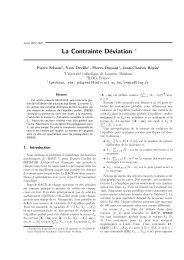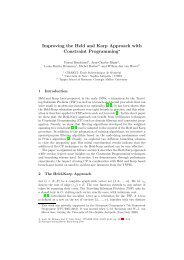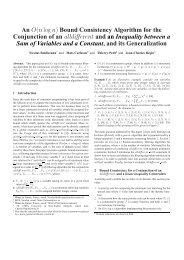The Deviation Constraint - Université catholique de Louvain
The Deviation Constraint - Université catholique de Louvain
The Deviation Constraint - Université catholique de Louvain
You also want an ePaper? Increase the reach of your titles
YUMPU automatically turns print PDFs into web optimized ePapers that Google loves.
<strong>The</strong> number of inconsistent instances <strong>de</strong>tected is significantly larger withthe presented propagator than with an implementation by <strong>de</strong>composition. Forinstance, with D max = 500, DEVIATION <strong>de</strong>tects 9, 619 inconsistencies against3, 628 with the <strong>de</strong>composition. On the 10, 381 consistent instances, the pruningpercentage obtained with DEVIATION is 11.8% against 0.9% with <strong>de</strong>composition.As shown in Section 6, all inconsistencies are not <strong>de</strong>tected by our propagatorif the mean is not integer. Since m = 0.5, some inconsistent instances canbe un<strong>de</strong>tected. Figure 5 shows a plot of the percentage of inconsistencies <strong>de</strong>tectedby <strong>de</strong>composition and DEVIATION approaches. Almost all inconsistenciesare <strong>de</strong>tected by DEVIATION. <strong>The</strong> lowest percentage is 99.66% for D max = 400.Percentage of <strong>de</strong>tected inconsistencies0 20 40 60 80 100Percentage of <strong>de</strong>tected inconsistenciesDEVIATIONDecomposition200 400 600 800 1000D maxFig. 5. Percentage of <strong>de</strong>tected inconsistencies.Section 7 introduces an approximation of SPREAD with DEVIATION. <strong>The</strong> leftof Figure 6 shows the number of inconsistencies <strong>de</strong>tected by SPREAD (as implementedin [7]) compared with the number of inconsistencies found by theapproximation. Many inconsistencies remain un<strong>de</strong>tected but, as shown on theleft of Figure 6, the propagation using DEVIATION is two or<strong>de</strong>rs of magnitu<strong>de</strong>faster than with SPREAD on these 20.000 random instances.9 ConclusionThis work presents DEVIATION, a new global constraint to balance a set of variables.This constraint is closely related to the SPREAD constraint [5, 7]. WhileSPREAD constrains the L 2 norm to the mean, DEVIATION constrains the L 1 norm.<strong>The</strong> filtering algorithms we introduce run in linear time with respect to thenumber of variables. Experiments evaluate the efficiency in terms of filteringof our propagators. A relaxation of SPREAD with DEVIATION is also introduced.Such a relaxation offers less filtering but significantly reduces the computationtime.14







